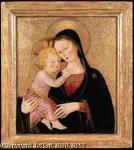Bartolomeo Caporali
Bartolomeo Caporali
Place: Perugia
Born: 1420
Death: 1505
Biography:
Bartolomeo Caporali (b Perugia, c. 1420; d Perugia, c. 1503 - 1505) was an Italian painter and miniaturist in Perugia, Umbria during the early Renaissance period. His style was influenced by Umbrian artists Gozzoli and Boccati, two of his first mentors, and continued to evolve as younger Umbrian artists came onto the scene, such as Fiorenzo di Lorenzo, Perugino and Pinturicchio. Although primarily a painter, he is also known for executing missals, restoration work, gilding, armorials, banners and celebratory decorations, which speaks to his decorative, detail-oriented artistic style. His most famous works include Madonna and Saints (1487) for the church of Santa Maria Maddalena at Castiglione del Lago, The Virgin and Child Between Two Praying Angels, and his Adoration of the Shepherds.
Caporali was born in the town of Perugia, Italy in 1420. He was from a family of artists, including his brother, Giapeco Caporali, and son, Giovanni Battista Caporali. His father was a highly trained soldier and fully armored cavalryman as a “man-at-arms”. Caporali married Brigida di Giovanni Cartolari before 1480 and together they had seven children: three daughters, Candida, Lucrezia, and Laura and four sons, Giovanni, who was also a painter, Ser Camillo, Giampaolo, and Eusebio. According to housing records, he lived in a house in the vicinity of San Martino in Perugia in 1456, which he co-owned with his brother Giapeco.
In addition to being an artist, Caporali was also highly involved in the politics of Perugia. He was prior of his town, camerlingo to the Company of Illuminators, was elected captain of the people and held leadership positions in the Umbria Painters Guild multiple times throughout his career. His opinion was highly valued in the art community, as he was frequently called upon to estimate the value of other artists’ works. He was known to have an extremely even emotional temperament, and in one instance is described as being “phlegmatic”.
His death occurred between 1503 and October 8, 1505, since a document of that date describes his son, a canon of San Lorenzo, as Ser Camillus quondam Bartholomei Caporalis, or “of the late Bartolomeo Caporali”. The last found document that mentions Caporali alive dates from 1503.
Caporali had an artistic style that is best described as chameleon-esque, as he was masterful at absorbing the new techniques, skills and fashions from his contemporaries. Although Caporali’s work was best known within Umbria, he constantly collaborated with provincial Renaissance painters in order to learn, network and develop his style.
One attribute known about Carporali’s work is his acute attention to detail. This can be seen in the particular detailing in his figure’s clothes in order to give substance and differentiate between fabrics; his angels’ robes have a velvety thickness, and his Madonnas have complex double drapes painted onto her cloaks. Additionally, his work is known for the gentle facial expressions of his subjects and the peculiar transparency of their facial skin tone. Strong hints of gold in the flesh, large infantile eyes with hard blackish lines under the upper lids, overlong fingers, and sensitive mouths drawn by long parallel brushstrokes are all details that define his work.
As with most Renaissance painters, Caporali's style transformed throughout his career as he was introduced and influenced by various artists. This pattern often relied upon which artists traveled and worked in Umbria, as well as younger, more talented contemporaries from Perugia that he learned and borrowed from. These artists included Gozzoli, Boccati, Benozzo, Bonfigli, Perugino, Fiorenzo di Lorenzo, and Pintoricchio. In his last works in particular, Caporali began strictly producing work related to the impersonal mass of religious Umbrian paintings which were inspired by Pintoricchio. The quality of his work severely declined with age, to the point at which his hand is almost unrecognizable in his last paintings.
Little is known about Caporali’s training, however there are two men that undoubtedly influenced his artistic career. Many art historians claim that he studied under Benozzo Gozzoli, whose influences are seen in many of Caporali’s earlier works. However, according to official records, Gozzoli didn’t travel to Umbria until Caporali was about 30 years old. Others claim Caporali to be the student of Giovanni Boccati, however there is the same chronological issue, as Boccati didn’t live in Perugia until 1445. Therefore, it is not known who first introduced Caporali or his brother to the art of painting. However, most art historians attribute the majority of Caporali’s training to Gozzoli.
The earliest documentary record of Bartolomeo Caporali is his matriculation in the Guild of Painters at Perugia in the year 1442. Additionally, in the late 15th century, an important local school of painting developed in Perugia, its principal exponents including Benedetto Bonfigli, Bartolomeo Caporali, Fiorenzo di Lorenzo, Bernadro Pinturicchio and later the great Perugino. Although he collaborated with all of these artists, Caporali worked particularly closely with Bonfigli during the beginning of their careers. In fact, modern art historians have trouble discerning between their early works due to their strong resemblances in technique, most likely because they were educated under like influences, if not the same master.
More...
Wikipedia link: Click Here









